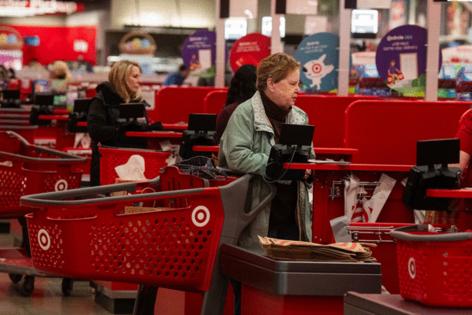Holiday spending to dip this season, upping competition for retailers
Published in Business News
Consumers plan to cut holiday spending this year, putting extra pressure on Twin Cities retailers for their critical shopping season.
Shoppers will shrink their holiday budgets by an average of 5%, the first notable decline since 2020, according to PwC’s annual Holiday Outlook survey. That decline five years ago occurred amid the pandemic and its curtailed holiday celebrations.
“Gen Z is just pulling back significantly,” said Kelly Pedersen, PwC partner, noting the younger generation is facing the highest credit card delinquency rates and shifting more spending toward experiences like concerts and travel, where prices have risen faster than goods.
Consumers are also anticipating a shorter shopping period, with most expecting to have their gift-hunting complete by Cyber Monday.
Minneapolis-based Target is prioritizing value and convenience to stand out from the competition. The retailer is leaning into shoppers’ economic concerns and truncated shopping schedule with seasonal campaigns, weekly promotions and expanded next-day shipping.
Fellow Twin Cities-based electronics company Best Buy and other retailers are also strategizing for a more competitive few months.
More than 84% of consumers expect to cut back spending in the next six months, citing rising prices, potential tariffs and a higher cost of living — on everything from cars to insurance premiums, the PwC survey found.
Retail sales data for August show consumers are still spending, but cautiously. Most of the 3.5% year-over-year growth is due to inflation, said Neil Saunders, managing director of GlobalData. Put simply, retailers are making more money on higher prices rather than increased consumer buying.
Volume, which looks at the actual number of products sold, rose 0.4%, down from 1.4% in July.
“Consumers are being very considered and deliberate about their spending,” Saunders wrote in an analyst note. “They’re shopping around, comparing prices and making sure they get more bang for their buck.”
Gen Z shoppers plan to slash budgets by 23% during the holidays — a sharp reversal from 2024, when their spending jumped 37%. Baby Boomers, meanwhile, plan to increase spending by 5%.
While younger consumers are tightening wallets, there are signs they’re emerging from the pandemic with stronger social connections and optimism. Analysts said that shift could bolster sales as Gen Z moves into its peak earning years.
It’s low-income households, however, that are feeling the greatest squeeze from inflation and slowing wage growth. More likely to live paycheck-to-paycheck, they are especially reactive to promotions and discounts, said Mark Mathews, chief economist at the National Retail Federation (NRF), in a fireside chat with Telsey Advisory Group.
Consumers likely won’t start seeing the bulk of price increases until the coming year because many retailers purchased holiday inventory in advance to avoid tariffs, Pedersen said.
“Based on the data, and what we talked to retailers about how they’re potentially passing on some of this, it’s belief,” Pedersen said. “It’s not like those prices are really flowing through to the economy yet.”
Shoppers are increasingly focused on essentials and value as tariff stress builds, Mathews said.
Retailers have so far absorbed the cost pressure from tariffs, but Mathews said the NRF expects price increases to accelerate during the holiday quarter.
While Target’s most recent earnings call focused largely on the appointment of Michael Fiddelke as the next CEO, tariffs were also a topic. The retailer attributed its higher inventory to increased product costs that tariffs and other factors have driven.
Compared to Walmart, which has spoken more openly about when and how tariffs will impact pricing, Target has focused on maintaining pricing in areas where customers would most likely notice increases, such as the discount section at the front of stores.
“We will continue to offer great value in the form of deals and promos and price, but also consumers are thinking about value much more broadly than that,” said Rick Gomez, chief commercial officer at Target, on a recent earnings call. “They’re thinking about it as quality and style and trend.”
Target’s latest fall campaign inspired its recent New York Fashion Week debut. The retailer’s fall strategy, which came 10 days before the official start of the season, highlighted a style relaunch, tailgate-inspired merchandise and new beauty assortments.
The event was also one of the first indications Target is making strides toward one of Fiddelke’s outlined goals as CEO: Reclaim the retailer’s status as a fashion-forward brand.
The chain is also expanding its next-day delivery service to 35 metro areas by the end of October, with 20 additional cities next year. Target offers same-day delivery to more than 80% of the U.S. population through Shipt, its delivery service subsidiary.
Amazon, by comparison, serves more than 140 metro areas, and Walmart reaches 95% of the U.S. population with next-day or two-day shipping.
Richfield-based Best Buy is widening its product mix through its digital marketplace, which now includes Halloween inflatables, licensed sports gear and exclusive tech bundles.
The retailer is pairing those offerings with early promotions, including a 48-hour flash sale Sept. 27-28. With PwC forecasting 80% of holiday shopping will be wrapped up by Cyber Monday, Target will also run one of its biggest sales events, Target Circle Week, Oct. 5-11. Weekly holiday deals will follow beginning Nov. 1.
“The biggest challenge for retailers this holiday is having the right assortment at the right price amid a lot of uncertainty,” according to an industry note from Telsey Advisory Group.
©2025 The Minnesota Star Tribune. Visit at startribune.com. Distributed by Tribune Content Agency, LLC.












Comments